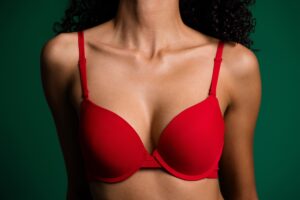Having children can be a remarkable gift, but there are several post-pregnancy changes in the breasts and body that linger even after giving birth. Breast lift surgery, a procedure designed to reshape and lift sagging breasts, is an extremely popular treatment option for women who have lost volume and shape in their bust during pregnancy. This can result in a flat, stretched, or elongated look in the breasts, which cannot be resolved with dieting and exercise. For many women, there is a strong desire to return to their pre-baby contours immediately after having kids. While we understand the urge to restore your pre-pregnancy figure as soon as possible, some patience can go a long way in achieving the best possible outcomes after breast lift surgery.... Continue Reading
Breast Lift
Breast implants can be extremely useful in giving patients the more voluptuous, custom breast contours they envision, but many patients wonder whether breast augmentation is the right solution for all aesthetic breast concerns. Stretched breasts are often a key concern for women, especially those who have had children or breastfed. When the breasts begin to look overly stretched, flat, or elongated, options to restore a more youthful-looking bust often include breast implants and mastopexy (known as breast lift surgery). Although breast implants typically provide the best results when utilized to add volume and/or achieve rounder, fuller breast contours, the breast augmentation procedure may not always be ideal in addressing a flattening of the breasts — especially if there is significant ptosis (sagging). However, this doesn’t... Continue Reading
There are a variety of hormonal fluctuations caused by pregnancy that can change the shape, size, and feel of your breasts. Varying estrogen and progesterone levels can catalyze a loss of the youthful contours that previously defined the shape and size of your breasts, leading to pregnancy-related changes such as: Stretched skin and areolas: Laxity in the skin and breast tissue can not only lead to the formation of stretch marks, but also may cause ptosis (sagging). In some cases, the breasts can droop to the point of sagging below the inframammary fold (breast crease). Loss of volume: As the breasts enlarge from milk production during pregnancy, many patients experience reduced fullness and volume in their breasts after giving birth. Reduced firmness: A loss of... Continue Reading
Over time, there are many factors that can cause the breasts to change shape. As glandular tissue begins to droop and the upper poles of the breasts lose fullness, it’s not uncommon for your breasts to grow softer and less elastic. For some patients, this occurs in their forties and fifties — for others, sagging develops as early as an individual’s thirties. In general, reduced firmness can be caused by: Weight changes: The breasts grow and shrink in proportion to a patient’s body frame, and fluctuations in weight and size are often the primary culprits behind the appearance of aging breasts. As the breasts adapt to weight-related changes in the body, the internal structures of the breasts begin to lose tightness and support. This can... Continue Reading
Breast implants can offer a dynamic and long-lasting way to improve the size, volume, shape, and symmetry of the breasts. By providing patients with the ability to truly achieve the custom contours they envision, breast implants are considered an integral part of aesthetic surgery. If you’ve ever considered cosmetic procedures to enhance your breasts, you may have wondered whether breast implants can address breast ptosis or sagging. Drooping or elongated breast tissue is an extremely common effect of aging, pregnancy, and weight loss on the breasts. While medically harmless, our board-certified plastic surgeon understands that breast sag can sacrifice a youthful look in the chest and potentially inhibit self-confidence. Each person’s needs and aesthetic concerns are evaluated on an individual basis, but in general, breast... Continue Reading
A popular misconception about breast ptosis — which refers to drooping and/or sagging breast tissue — involves the notion that the primary cause of sagging is breastfeeding or nursing. In truth, sagging breasts are usually caused by the shape and size of the breasts fluctuating throughout pregnancy. Having children typically causes the breasts to temporarily enlarge, resulting in stretching of the overlying skin and increased inelasticity. Following pregnancy, the breasts often return to their original size; however, the skin may remain stretched. This not only flattens the breast contours, but can also result in a pendulous or drooping appearance. Breastfeeding may exacerbate breast sag, but the condition is generally more the result of pregnancy rather than nursing. There are many effective measures patients can take... Continue Reading
Breast lift surgery, or “mastopexy,” is one of the most sophisticated procedures to address signs of aging in the breasts, such as skin inelasticity, excess glandular tissue, and an overall loss of support. By removing redundant fat, skin, and tissue causing ptosis (or drooping), mastopexy can provide a firmer and younger-looking breast profile. That said, some patients wonder whether the removal of excess tissue adjunctively results in a smaller breast size. A breast lift does not significantly decrease the proportions of the breasts; rather, the procedure seeks to improve changes in the breasts caused by the natural aging process, such as flat or elongated breast contours. While the main objective of a breast lift is not to obtain a smaller breast size, the procedure is... Continue Reading
As we age, our bodies change in response to some of life’s biggest moments. Specifically, the appearance of firm and youthful breasts can fluctuate with age and multiple factors usually contribute to these developments. From pregnancy and breastfeeding to weight fluctuations, the breast contours tend to look flatter and less shapely over time. Menopause and the natural aging process are also contributing factors, especially when the body starts producing less estrogen. While the age-related changes to your breasts vary from patient to patient according to genetics and unique lifestyle factors, there are certain concerns widely shared by women as they get older. Many patients want to improve: Breasts that look elongated, have lost volume, or appear deflated A decrease in skin elasticity and firmness Nipples... Continue Reading







